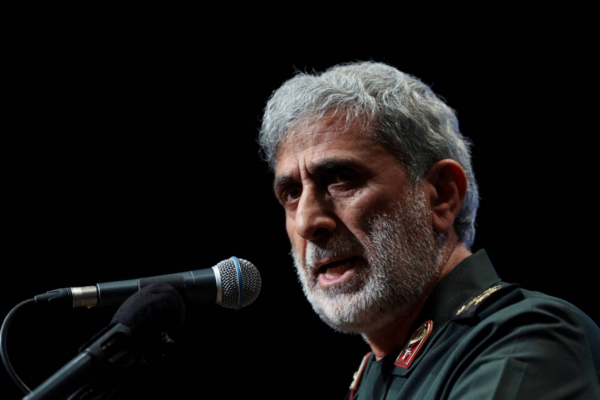FILE PHOTO: Brigadier General Esmail Qaani, the head of the Revolutionary Guards’ Quds Force, speaks during a ceremony, in Tehran, Iran April 14, 2022. Majid Asgaripour/WANA (West Asia News Agency) via REUTERS
Iran’s Quds Force commander Esmail Qaani, who traveled to Lebanon after the killing last month of Hezbollah leader Hassan Nasrallah in an Israeli airstrike, has not been heard from since strikes on Beirut late last week, two senior Iranian security officials told Reuters.
One of the officials said Qaani was in Beirut’s southern suburbs, known as the Dahiyeh, during a strike on Thursday that was reported to have targeted senior Hezbollah official Hashem Safieddine but the official said he was not meeting Safieddine.
The official said Iran and Hezbollah had not been able to contact Qaani since then.
Israel has been hitting multiple targets in Dahiyeh as it pursues a campaign against Iran-backed Lebanese group Hezbollah.
The second official also said Qaani had travelled to Lebanon after the killing of Nasrallah and the Iranian authorities had not been able to contact him since the strike against Safieddine, who was widely expected to be the next Hezbollah chief.
Hezbollah has made no official comment so far on Safieddine.
The Quds Force, the overseas arm of Iran’s Revolutionary Guards, oversees dealings with militias allied with Tehran across the Middle East, such as Hezbollah.
Iranian Revolutionary Guards commander Brigadier General Abbas Nilforoushan was killed with Nasrallah in his bunker when it was hit on Sept. 27 by Israeli bombs.
Who is Qaani
Here are some facts about Qaani:
– Tehran named Qaani the head of the Revolutionary Guards Corps’ overseas military intelligence service after the United States assassinated his predecessor Qassem Soleimani in a drone strike in Baghdad in 2020.
– Part of Qaani’s task in that post has been to manage Tehran’s paramilitary allies across the Middle East, as well as in other regions around the world.
– According to people familiar with both Qaani and Soleimani, as well as Western military and political analysts, Qaani has never commanded the same respect as his predecessor Soleimani or maintained the same close relationships among Iran’s allies in the Arab world.
– While Soleimani held the reins of the Quds Force during a time when Iran’s proxies – from Lebanese Hezbollah to Iraqi Shi’ite Muslim militias to the Houthis of Yemen – grew their power in the Middle East, Qaani has presided over their battering at the hands of Israeli spies and warplanes.
– Qaani became deputy commander of the Quds Force, the overseas arm of Iran’s Revolutionary Guards, in 1997 when Soleimani became the Force’s chief commander.
– When Qaani took over he vowed to boot U.S. forces out of the Middle East in revenge for Soleimani’s killing. “We promise to continue martyr Soleimani’s path with the same force … and the only compensation for us would be to remove America from the region,” state radio quoted Qaani as saying ahead of Soleimani’s funeral in Tehran.
– Qaani, 67, was born in Mashhad, a conservative Shi’ite Muslim religious city in northeastern Iran. He fought for the Revolutionary Guards during the Iran-Iraq war in the 1980s.
– Qaani has also had experience of overseas operations beyond Iran’s eastern borders, including Afghanistan and Pakistan. He does not speak Arabic, unlike Soleimani who spoke fluently with Iraqi militias and Hezbollah commanders.
– He has adopted less of a public persona than Soleimani and little information is available on him online or in leaked diplomatic cables.
– Unlike Soleimani, who over the years was widely photographed on battlefields in Iraq and Syria alongside the militias Tehran has armed and trained, Qaani has preferred to keep a lower profile and conduct most of his meetings and visits to neighboring countries in private.
Asharq Al Awsat/ Reuters


Leave a Reply
You must be logged in to post a comment.